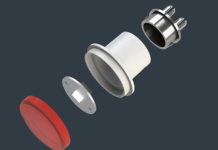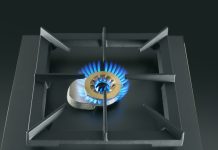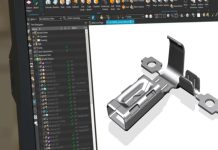Not only excellence designers but also in-house more and more skilled technical offices, ready to investigate the potentialities of all household appliances. If a TV set can become sexy and protagonist of an environment, why shouldn’t a washing machine or a hood try, too?
Silvia Fissore
Also in the sector of “white” appliances, design is becoming more and more important as system to differentiate products one another and to increase their value. The sector has always linked its production with the name of famous designers, called for the occasion to design lines or single products, but for about one decade the white good industry is following with more awareness the course already traced by consumer electronics and automotive, where the design is deemed an essential instrument to communicate one’s own innovation effort and to boost the consumer’s response.
But some essential differences anyway remain. In the world of brown goods, in fact, the life cycle of products is much shorter than household appliances’ and the aesthetical appeal often counts more than functions. In the white good industry, on the contrary, the appliance still has its own “life” as to the aesthetical quality of its external shell. The consumer replaces the washing machine not to have the nicest one at home but mainly because he must substitute the broken appliance with a new one, whose functions are better than the previous one’s and in line with the users’ needs. And if, in general, the challenge of each designer consists in designing shapes not subjected to fashion, which go beyond the temporary trend and able to transform the object into an icon that succeeds in influencing a determinate sector, in the case of the designer of household appliances to win the challenge means most of all to create the right object at the right price to satisfy a real need. Energy efficiency, ergonomics, functionality, use safety are the constant factors that influence the project of a household appliance and the design is at their service. The “fine” shape tells nothing to the consumer if it is not called to represent also a technological content keeping pace with times. Nevertheless, it is increasingly clear the white good companies’ effort of introducing a new element into the creative process: emotionality. Also a washing machine or an oven, a refrigerator or a hood can have an aesthetical-functional appeal able, as in the case of an Ipad or of a SmartPhone, to emotion the user. Concerning this, an important role among the forerunners has been played by Indesit Company that, in the washing sector first with Margherita and afterwards with Aqualtis, has intended to outline a new image of the washing machine, enriching it with emotional aspects making it less “machine” and more “human”. In Aqualtis in particular, for the first time, the washing machine stood out physically and aesthetically in the context and in the domestic environment of the user, taking up a space in totally new volumetric as well as visual terms. Aqualtis was proposed as the washing machine not to be hidden or to be relegated in a service environment, but as a functional and pleasant object to the sight, with a strong aesthetical value dictated by the colour, the lines and by the porthole design.


Design versus Far East
The players that want to be competitive know that the design may constitute a very important marketing boost, especially in the present context where the European industrial enterprises, which are in the forefront in the production of certain products, start experimenting the strong competition by “far East”. The white good manufacturers are suffering the impact, or better the impact force of new “enterprises” that have acquired part of the productive competencies contained in the European DNA and that now can offer the same products at lower prices, thanks to inferior investments in research & development and to government systems where the labour cost is much lower. In this case the capability of satisfying the market demands in due times makes the difference in the competition. But it is worth reminding that the rapidity with which a product is proposed on the market depends on the capability of integrating the design into the production process. The white good industry, then, is by now aware that certain products have conquered markets just – even if obviously not only – for reasons of aesthetical nature.

Multi-disciplinary synergies
The industrial designer, who today is a figure half way among the engineer, the architect and the creative problem-solver, if he wants to fulfil his role, must be always informed about the social, economic and cultural implications of the mass market. If it is true that the primary task of the industrial design consists in projecting some new products to which the new technologies have given birth, we cannot forget that the creation process of objects is strictly connected with the “human” environment. For this reason, the designer’s intervention ambit is increasingly limited to communication and marketing dynamics. The designer is called to give shape to material objects and to do that effectively he must establish a relationship, or better a dialogue, with end-users. Marketing and communication are the two instruments requested to collaborate to allow and make efficient this dialogue.
The designer of household appliances starts his work together with a multi-disciplinary group and he must intervene since the initial phase, that’s to say he must participate already at the concept design time. In this phase they start from the analysis of the object from the technical point of view, to reduce it to its essential form freeing it from all secondary influences and purely aesthetic trappings. The goal is to give the finished object a logic shape able to communicate immediately its function to the user, helping him in his purchase choice. The designer’s intervention is undoubtedly useless when the technical design is already in an advanced stage, if he is requested to devise a bodywork, an external shell for the mechanical part already implemented.
“The age of Archistars has ended” affirms Makio Hasuike, who for over 40 years has been linking his name with the household appliance world, having worked at the most important projects by Indesit Company. “The industrial designer does not work any more for elites, as in the Sixties-Seventies, but for the community of consumers. And, most of all, he pursues not a personal but a team work. His task consists in organizing a team according to the problem to be solved and faced. The final result of the design is the integration of technologies and shape, solving in optimal way all the components of a design problem: to choose the most suitable materials, the most correct techniques, to experiment their possibilities keeping into account the psychological component, the cost, functions and requirements “.
The team work, managed by the designer, then has the function of collecting and coordinating an interdisciplinary whole of competences, on their basis to devise the project in creative way and to give shape to the object, satisfying both the aesthetical and the practical aspects of the production. “To design household appliances partly means to give up our individualism – affirms Hasuike – and to learn working in team with the company’s men, dialoguing with the management. You must be able to acquire, to that end, a common vision “.

Small household appliances and refrigeration
If we make a comparison between white and brown goods, it is clear that the research in the product design field has given excellent results in the small appliance industry. It is in this market that lots of objects have turned from simple tools for the food preparation or the body care into real elements bearing an aesthetic plus that has influenced the consumer’s choice. In particular the appliances for the food preparation are the category where the design aspect cannot be set aside in the choice. Companies such as Kitchen Aid, for instance, have carried out real market studies about the colour, the material finishes and ergonomic shapes, besides researches about the technological upgrade. The new range of kitchen robots proposed by the company, then, is characterized by a high design content distinguished not only by pure and timeless shapes but also by unusual colours for the household appliance world and borrowed from the fashion ambit, like crystal blue, pearl and fluorescent shades. The goal is to transform the appliance into a real piece of furniture that aesthetically characterizes the kitchen and satisfies the user’s touch sensations thanks to the rounded and smooth surfaces.
Still remaining in the “kitchen”, in the last fifteen years the refrigerator has changed into a real totem thanks to the greater and greater aesthetic appeal in free-standing models. Producers, in fact, have worked from time to time at retro and evocative shapes, or at minimal and hi-tech lines, focusing on materials with strong tactile and visual impact, such as stainless steel and on apparently light details such as handles or inside finishes. And just in the design of interior spaces they have made strides: the restyling has lived a new subdivision of spaces dictated by a not only aesthetical but also functional logic, completed by an attentive choice of materials such as the hardened glass, warranty of duration and reliability, or of led lighting systems that, besides improving the appeal, have communicated a new idea of safety and technology to consumers. And just on the refrigerator the first experimentations have been made, or better, contaminations with the entertainment world, equipping these appliances with real computers and with interfaces designed to dialogue with users.

Built in, we can dare more
But let’s look at the Built in world, too. “In the built-in sector there is much talk about design, considering that the appliances must be integrated into a furnishing context. We often witness, however, a real standardization of the offer that leads to trivialize all ” explains Christophe Collet, Marketing manager Cooking and Built In Business Sector of Candy.”Nevertheless they are products where the aesthetic factor counts a lot in the consumer’s choice since their expected life is 15-20 years”. And just starting from the attempt of overcoming this trivialization of shapes and materials, the research & development team of Candy has given birth to a hob that today is still in the prototyping phase but has already been on show in a design exhibition thanks to its high aesthetical-functional content. In the new cooking hob the design is represented, in fact, by the perfect synthesis of technology and materials: a single stainless steel ultra flat die houses burners made flush with the plate and functioning with forced air to optimize the efficiency in terms of combustion and consumptions. “Our team – further explains Collet – has worked on two trends that characterize today’s kitchen: minimalism and integration of the household appliance into the surrounding environment “.


Hoods teach
In the last decade the hood is the household appliance that in its stylistic evolution has more approached the world of brown goods. These appliances, in fact, have emerged from the kitchen’s linear shapes to gain their own dignity and an autonomous life thanks to producers’ capability of breaking with the traditional canons and of experimenting new shapes. And all that even if the engineering of these products is not one of the simplest. “The hood, in fact, even allowing an interesting game of experimentation on shapes and materials – explains Fabrizio Crisà Design Center Manager of Elica – is at the same time an appliance that imposes heavy binds dictated by safety regulations to the designer, since it is a household appliance that must function under determinate conditions (high temperatures, presence of steam and of acid substances) and must guarantee adequate suction power “. The greatest difficulties in the product implementation were especially found in the choice of materials, on which at the same time depends the aesthetical result of the appliance. “Plastics, for instance, to withstand temperatures up to 140 °C as provided for by safety, must be charged, then they lose transparency. The shatterproof hardened glass, also in this case imposed by safety directives, is not suitable for all shapes.
But troubles have not stopped the players’ constant effort towards more and more innovative aesthetical-functional solutions. The result is that today the consumer who chooses a hood uses aesthetics as main choice criterion, giving for granted the two essential functions of this appliance, that’s to say the suction power and the presence of luminous sources to light up the cooking hob. Exactly the contrary, then, of what happens in the purchase of a washing machine or of a dishwasher, where the aesthetical appeal is of secondary importance.

“Since the beginning our company – explains Fabrizio Crisà design centre manager of Elica – has set the target of transforming an apparently secondary appliance, such as the hood, into a design object able to become a piece of furniture and to confer a personal touch to the environment where it is introduced”. In this sense, one of the emblematic models of the Marche company has certainly been the hanging hood that evokes the idea of a chandelier (emphasizing the lighting function of the appliance) and that has even succeeded in freeing itself from the kitchen context to enter the living as protagonist.




